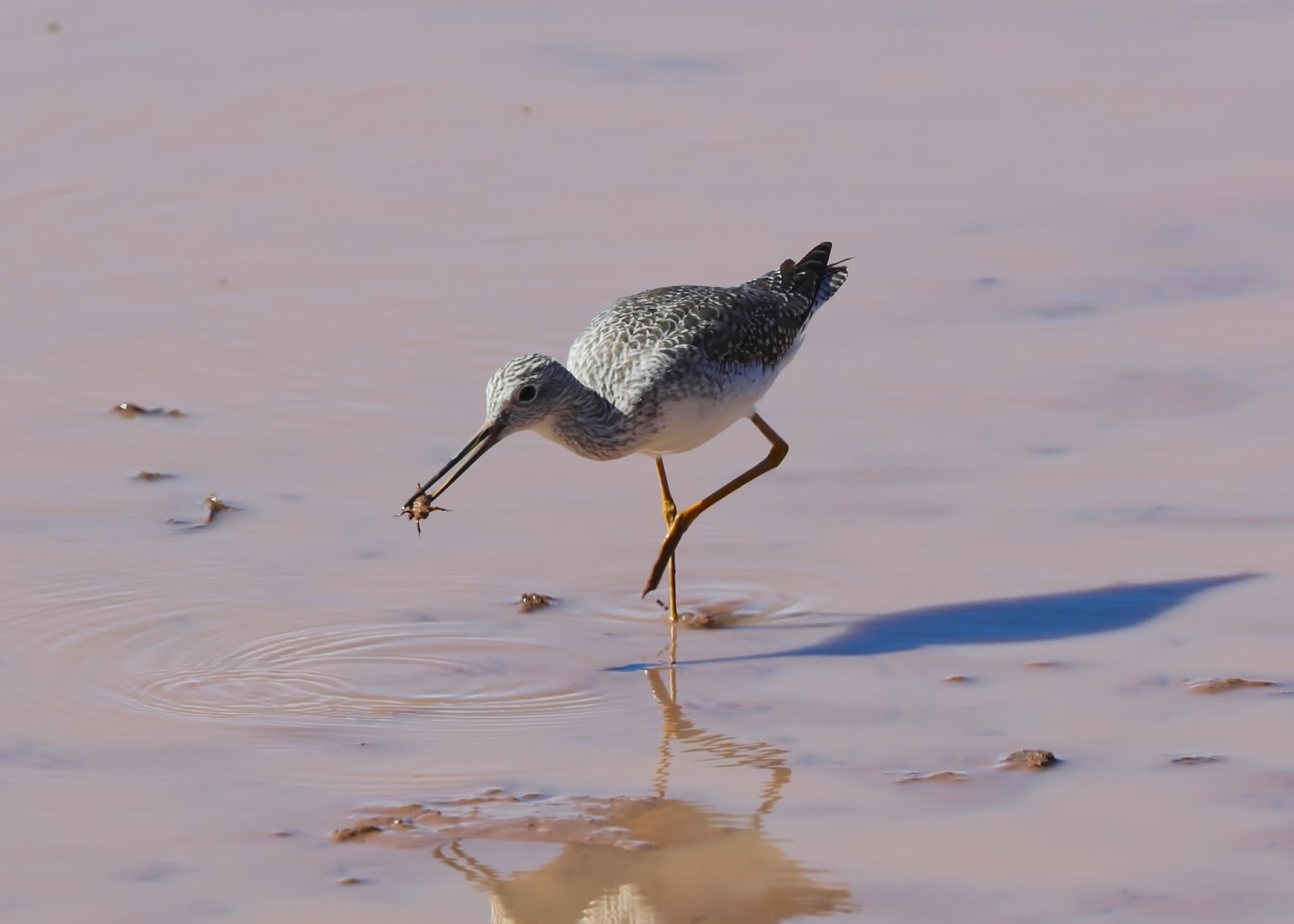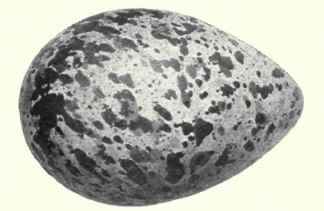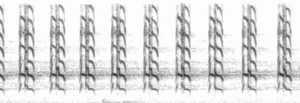
ORDER: Charadriiformes
FAMILY: Scolopacidae
GENUS: Tringa
SPECIES: Tringa melanoleuca
Introduction
The Greater Yellowlegs is a shorebird located in almost all parts of North and South America, during various seasons. Tringa melanoleuca is a relatively slender bird with a long neck and a small head. They have long, bright yellow legs and a long bill in order to feed in tidal areas. The coloring of T. melanoleuca is grey and white, white on the belly, and grey stripes and spots on the upper half of the body. They are usually seen standing in the water in wetlands, but are also observed flying, and by a distinct call of high pitched chirps. It is estimated that the shorebird group originated more than 90 million years ago. The diverse clade of birds has a remarkable range of behavior, morphology, and life history traits (Gibson 2012).
- Length: 11.4-13.0 in (29-33 cm)
- Weight: 4.5-7.7 oz (128-219 g)
- Wingspan: 23.6 in (60 cm)
(The Cornell Lab of Ornithology)
(Birds of North America, The Cornell Lab of Ornithology)
Population size of T. melanoleuca in North America has stayed consistent over decades, at around 100,000 individuals, however this species was counted with a fairly low accuracy rating (Guy Morrison 2006). Approximately 90 Greater Yellowlegs were recorded in two estuarine sites in Brazil from 2008-2009, indicating a strong presence in South America as well (Fredrizzi et. al, 2016).

(Oregon Department of Fish and Wildlife)
The nests of the Greater Yellowlegs have a tendency to be built at the base of coniferous trees in wetland areas. They are typically a relatively shallow depression in moss or peat and are lined with leaves and lichen.
 (The Azure Gate)
(The Azure Gate)

(Greater Yellowlegs Egg, from ChestofBooks.com)
NESTING FACTS
| Clutch Size: | 3-4 eggs |
| Number of Broods: | 1 brood |
| Egg Length: | 1.7-2.1 in (4.4-5.4 cm) |
| Egg Width: | 1.2-1.4 in (3.1-3.5 cm) |
| Incubation Period: | 23 days |
| Egg Description: | Gray to brown with dark markings. |
| Condition at Hatching: | Downy and able to walk. Young leave nest a few hours after hatching and feed themselves. |
(Table made by The Cornell Lab of Ornithology)
Link to Macaulay Library archive of Greater Yellowlegs call and song recordings.
https://search.macaulaylibrary.org/catalog?taxonCode=greyel&mediaType=a&sort=rating_rank_desc&__hstc=75100365.37bc7c82037e16423847c94f02bf7723.1549338879070.1552527139516.1552529612036.6&__hssc=75100365.2.1552529612036&__hsfp=2020398392#_ga=2.223783442.848826025.1552521788-1469945088.1549338876
During migration T. melanoleuca can travel hundreds of miles from Canada to South America. Their migration times are in the Spring and Fall, traveling to and from mating locations (Buchanan 1988). During travel these birds fly in loose groups, but are overall generally solitary compared to other migrating birds. They are usually seen solitary when standing in the shallows on their tall, yellow legs. At nighttime however, they roost in large compact groups with other shorebird species. When trying to attract a mate, males will preform dives and mating songs in front of females, as well as run around her in circles.

(Photo courtesy of flickr.com, Greater Yellowlegs in Flight)
There are many efforts happening around the world to protect wetland habitats, and other unique environments important to the survival of shorebirds. In San Francisco, restoration of former salt evaporation ponds has increased the abundance of shore bird populations by 5.7 times the historical amount (Athearn 2009). According to recent endangered and threatened species reports, T. melanoleuca is not currently threatened (Gaydos and Brown 2011). Other restoration efforts in the Colorado River Delta in Mexico show that shorebirds are utilizing the resources in both natural and anthropogenic wetlands, indicating that the birds are not always harmed by development and are able to adapt to their changing surroundings (Gomez-Sapiens et al. 2013). However, it there is usually a better chance of survival in a completely natural habitat.
Like countless other species, migrating shorebirds will have to adapt to the changing climate in order to survive. Studies have shown that shorebirds are capable of adapting their migrating habitats, during dry years when their usual stopping locations are dried up (Steen et. al, 2018).
Athearn, N. D., Takekawa, J. Y., & Shinn, J. M. (2009, January 1). Avian response to early tidal salt marsh restoration at former commercial salt evaporation ponds in San Francisco Bay, California, USA. Natural Resources and Environmental Issues, 15, 77-86.
Buchanan, J. B. (1988, October). Migration and Winter Populations of Greater Yellowlegs, Tringa melanoleuca, in Western Washington. The Canadian field-naturalist, 102(4), 611-616.
Buchanan, J. B. (2007, January). Changes in the seasonal abundance of Greater Yellowlegs at Totten Inlet, Washington. Bird Populations, 8, 21-25.
Elliott, J. A., & Elliott, G. H. (2015). Resident Greater Yellowlegs on the Eastern Shore of Nova Scotia. Proceedings of the Nova Scotian Institute of Science, 48(1), 79-89.
Fedrizzi, C. E., Carlos, C. J., & Campos, A. A. (2016). Annual patterns of abundance of Nearctic shorebirds and their prey at two estuarine sites in Ceará, NE Brazil, 2008–2009. Wader Study, 123(2), 122-135.
Gaydos, J. K., & Brown, N. A. (2011, October 25). Species of Concern within the Salish Sea: changes from 2002 to 2011. Salish Sea Species of Concern, Proceedings of the 2011 Salish Sea Ecosystem Conference, 1-12.
Gibson, R., & Baker, A. (2012, April 2). Multiple gene sequences resolve phylogenetic relationships in the shorebird suborder Scolopaci (Aves: Charadriiformes). Molecular Phylogenetics and Evolution, 62, 66-72.
Gomez-Sapiens, M. M., Soto-Montoya, E., & Hinojosa-Huerta, O. (2013, May 9). Shorebird abundance and species diversity in natural intertidal and non-tidal anthropogenic wetlands of the Colorado River Delta, Mexico. Ecological Engineering, 59, 74-83.
Kelly, J. P. (2015). Restoration of the Giacomini Wetlands stimulates winter population growth Shorebird Recovery in Tomales Bay. The Ardeid.
Marcot, B., & Handel, C. M. (2015, March). Supplementary material for: Predicted changes in wildlife habitats in Arctic natural areas of northwest Alaska. ResearchGate.
Nareff, G. E., Schweitzer, S. H., Wiggers, E. P., & Mills, W. E. (2016, March 1). Time-activity Budgets of Yellowlegs in Managed Tidal Impoundments and Adjacent Tidal Marshes. JSAFWA, 220-224.
Steen, V., Skagen, S. K., & Noon, B. R. (2018). Preparing for an uncertain future: migrating shorebird response to past climatic fluctuations in the Prairie Potholes. Ecosphere, 9(2).


Leave a Reply